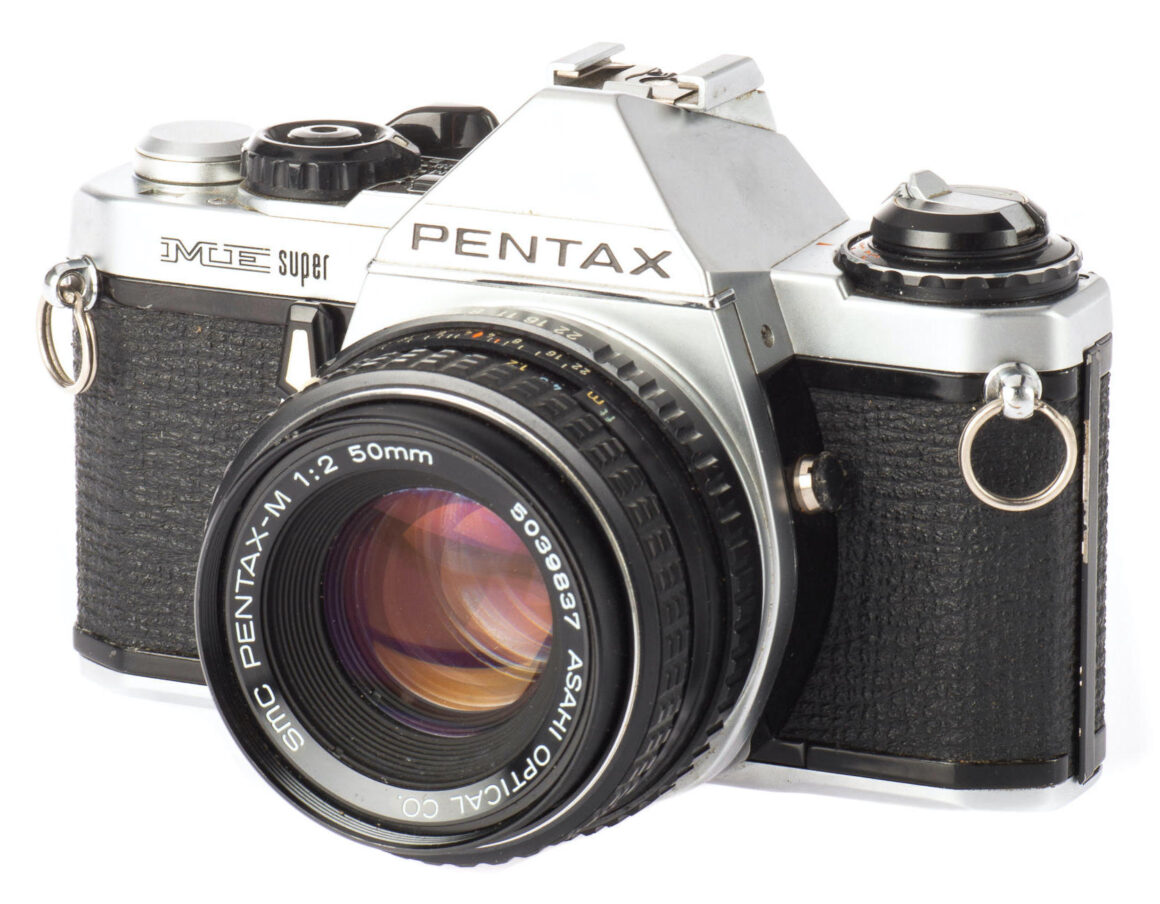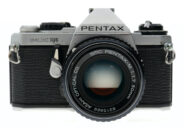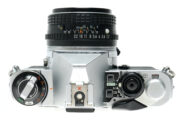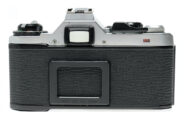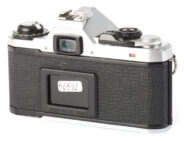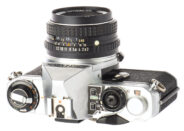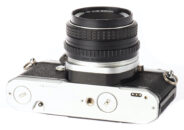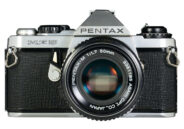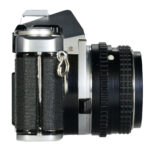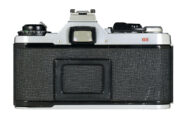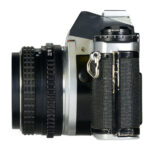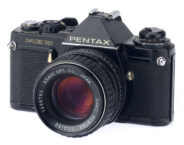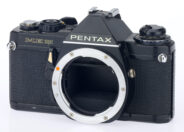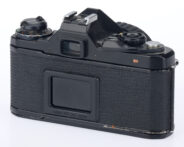Pentax ME super
35mm MF film SLR camera • Discontinued
- Announced:
- · December 1979
- Production status:
- ● Discontinued
- Country of design:
- · Japan
- System:
- · Pentax K (1975)
Specification
| Format: | |
| 35mm full frame | |
Film type: | 135 cartridge-loaded film |
| Pentax K [45.5mm] | |
| Shutter: | |
Type: | Focal-plane |
Model: | Electronically controlled |
Speeds: | 4 - 1/2000 + B |
| Exposure: | |
Exposure metering: | Through-the-lens (TTL), open-aperture |
Exposure modes: | Aperture-priority Auto |
| Manual | |
| Physical characteristics: | |
Weight: | 445g |
Dimensions: | 131.5x83x49.5mm |
Manufacturer description #1
Pentax cameras have played an important role in the development of the 35mm single-lens-reflex (SLR) camera. From the very day we introduced the Asahiflex - the company's first 35mm SLR - over 28 years ago, Pentax cameras have pioneered in the development of the SLR system with such innovations as the quick-return mirror, through-the-lens metering, popularization of eye-level pentaprism viewing, and the development of fully automatic electronic shutters, to name a few.
As an outcome of our innovativeness, especially in the field of electronics, we are proud to introduce to you another first - the Pentax ME SUPER - the world's first SLR to feature dual "shutter-dial-less" exposure systems: standard fully automatic exposure and revolutionary new "electro-manual" exposure control. Moreover, not only does this remarkable new camera feature fully "shutter-dial-less" operation in both auto and manual modes, but a host of other amazing features, such as the Pentax MFC-E2 vertical-run metal focal plane shutter with a super-fast 1/2000 second top shutter speed - the fastest ever in an ultra-compact camera; innovative 3-color LED display that lets you know instantly the exact status of your exposure; provision for dedicated electronic flash, and winder, and much more.
TWO CAMERAS IN ONE
SO EASY... BUT SO PROFESSIONAL
The ME SUPER is truly a unique and exciting camera. Not simply because it's a smooth handling, ultra-compact offering you both auto and manual exposure control - other compacts offer this. But, because it features two fully computerized exposure systems that are both equally unique, and equally practical. Both systems, in fact, are so easy to use and so professional that it could best be described as two cameras in one.
On AUTO, it's a fully automatic compact, featuring its own version of that now famous "shutter-dial-less" auto exposure control originally developed for the Pentax ME. You merely adjust the lens aperture to agree with the lighting conditions in the picture, and check the exposure. The camera then selects the precise shutter speed, steplessly, over a vast shutter speed range running all the way from 4 seconds to a remarkable 1/2000 second - an unprecedented top shutter speed for such a small camera.
And, equally as remarkable is the fact that even inexperienced photographers can get fantastic results with this mighty compact the first time out. This is due partly to the fact that the camera is so easy to use, and also to the use of incredibly precise GPD (Gallium Arsenic Phosphorus Photo Diode) metering cells - the most exacting on the market. As a result, exposure accuracy is unexcelled no matter who presses the shutter button.
For the same basic reason, advanced amateurs and professionals love the ME SUPER's auto exposure control system: Its reliability is unmatched. Not only do the quick-response GPD cells assure optimum results when shooting in a hurry, but the camera's easy handling and broad shutter speed range also give it a greater range than other cameras in its class.
The other convenient features of the ME SUPER's fully automatic exposure system are equally as invaluable. Such useful innovations as Pentax's newly developed 3-color "Stop/Go" LED display in the viewfinder, which even signals you when to use flash or take precautions against picture blur... a new-type finder-screen matte for unbelievably bright focusing... an enlarged air damper that assures extremely quiet operation.
There's even provision for a dedicated electronic flash: when compatible Pentax auto flash units such as the AF 200S or AF 160 are used, the flash is synchronized automatically at a fast shutter speed of 1/125 second, while the LED "flash ready" indication is also given in the viewfinder when the flash unit charges.
The above features alone are enough to make the ME SUPER a tempting choice for the photographer seeking a handy camera that brings results. But there's more- there's still that "other camera" we mentioned.
Simply switch the exposure mode dial to "M" and activate the metering system for a totally new experience in photography. Immediately, the camera switches over to the revolutionary electronic manual exposure system. Like AUTO, this unique system is also "shutter-dial-less." To select the shutter speed, look through the viewfinder and press either of the two feather-touch pushbuttons located beside the exposure mode dial. When you press the forward button, the LEDs alongside the viewfinder shutter-speed scale climb sequentially from slower to faster shutter speeds. Conversely, when you press the rear button, the LEDs descend the scale. Once you reach your desired speed, merely adjust the lens aperture to zero-in on the correct exposure. It's that simple, in fact, some photographers even use "M" as their main mode setting - occasionally switching to "auto override," of course.
Moreover, in the "M" (Manual) mode, you get all the essential extras, the same as auto: the same quiet operation, 3-color LED readout, provision for dedicated electronic flash, provision for the fast 2 fps Winder ME II and so forth.
The amazing Pentax ME SUPER. Whether you choose "AUTO" or "M" as your main shooting mode is up to you. Either way, you get professional quality with minimal fuss!
Manufacturer description #2
Pentax would like you to recall the days of manual through-the-lens metering. Or, if you don't mind dating yourself, the days when a meter was something you carried in your hand and used to meticulously measure light. So that you could turn the act of making an exposure into a true act of creativity.
AUTOMATION HAS ITS PLACE
Pentax makes several automatic exposure single-lens reflex cameras. So you know we're highly commited to this form of photography. No matter how advanced you are in photographic technology, there is no substitute for automation for its speed in responding directly to your images.
And yet, when you have the time to analyze your subject, the light and a mental image of the final photograph, there's no substitute for the control of manual metering.
To assimilate these two very distinct photographic philosophies, we developed the ME Super.
THE BEST OF BOTH WORLDS
Until the advent of the Super camera, most automatic cameras featured manual control as something of an "add on" feature. They could be used for manual in many cases. But never with the full facility of a camera built for manual metering.
In the ME Super, there are two discrete systems. One is a fully automatic, electronic, aperture-priority exposure system of outstanding accuracy. It will yield near-ideal exposures under a wide range of conditions.
The other system is the innovative Pentax ElectroTouch manual override, in which we replaced the ubiquitous shutter speed dial with a pair of push buttons. When you press one, the speed increases; when you press the other, it falls. It's a system that would do justice to the best-conceived all-manual camera.
In every sense of the word, the Pentax ME Super is two cameras in one, neither of which compromises the other in any way.
TOTAL CONTROL
With the ME Super's manual control, you can make virtually instantaneous exposure adjustments, fine tuning the light or bracketing for security. As a critical photographer, you know that as little as 1/2 stop can mean the difference between an exciting photograph and an also-ran.
With the ME Super, total control is literally at your fingertips.
EXTRA SPEED WHEN YOU NEED IT
Something else you'll find on the ME Super is a top shutter speed of 1/2,000 second. It's only on a few cameras in the world. And it isn't on any in the Super camera's price range. This high speed is an invaluable feature for stopping ultrafast action or shooting in bright light with high-speed films.
And it, too, is available at the touch of a push-button switch.
WHEN THE LIGHT'S NOT RIGHT
There are times when you're faced with lighting that can't be accomodated by any manual or automatic system without continuous compensation. So that's just what the ME Super has. Its handy exposure compensation dial lets you set the camera to compensate for high-contrast scenes (in the snow, at the theater) and continue to shoot either automatically or manually as if the light were normal.
LENSES ARE EVERYTHING
A fine camera is nothing without a fine system of lenses to back it up.
Each of the more than 40 Pentax lenses in out line is Super-Multi-Coated (a 7-layer Pentax innovation) on every surface. It's costly and time-consuming. But it reduces flare to negligible levels and increases contrast and color saturation to a corresponding degree.
Pentax lenses are a perfect match for Pentax cameras, with a consistent optical performance, color rendition and "feel" from focal length to focal length. And each features the Pentax bayonet mount (another Pentax innovation), one of the fastest and most secure ever designed.
AN INSTANT CLASSIC
The ME Super has become, in a very short time, one of the most popular new SLRs ever introduced. It is the ideal non-compromise camera, whether your photographs are based on the instant reactions of automation or the studied manipulations of manual.
Manufacturer description #3
TYPE: 35mm SLR camera with aperture-preferred automatic exposure; "pushbutton" electronic manual; auto flash sync (with AF 200S and AF 160 Units)
MOUNT: Pentax Bayonet Mount with fully automatic diaphragm linkage
SHUTTER: Seiko MFC-E2 vertical-run metal focal plane shutter; automatic shutter speeds electronically controlled between 4 sec. and 1/2000 sec. (stepless variation); electronic manual shutter speeds at 14 viewfinder settings (varied by dual pushbutton controls), plus mechanical settings of "125X" and "B" (operates without batteries at mechanical settings); selection via exposure mode dial; shutter button lock also provided
AUTO FLASH SYNCH: Synchronizes automatically with AF 200S or AF 160 Flash Units at 1/125 sec. via hotshoe in both "AUTO" and "M" modes. LED flash synch/ready indication provided in viewfinder
MANUAL FLASH SYNCH: Direct X synch via hotshoe or cord synch via X socket on camera body; 1/125 sec. flash synch speed at "125X" setting of exposure mode dial
SELF-TIMER: Delays shutter release 4-10 seconds
EXPOSURE METERING: Open aperture, center-weighted through-the-lens light metering by GPD cells. Exposure range from EV 1 - EV 19 (ASA 100 with 50mm f/1.4 lens). Film speed range: ASA 12 - 1600; 3-color LED shutter-speed readout in viewfinder. (20-35 sec. display given on particularly pressing shutter button which acts as metering switch +/2 EV exposure compensation via dial (1/4X, 1/2X, 2X, 4X)
VIEWFINDER: Silver-coated pentaprism finder with split-image/microprism focusing screen; shows 92% of the picture area, 0.95X magnification with 50mm lens; -1.0 diopter eyepiece (accepts correction eyepieces)
VIEWFINDER INDICATIONS: 2-color shutter speed readout: GREEN LEDs indicate speeds from 1/60 to 1/2000 sec. (adequate range for handheld shooting) YELLOW LEDs give camera shake warning for speeds from 4 sec. thru 1/30 sec.; RED LED "OVER/UNDER" exposure warning; RED LED exposure compensation warning, "M" (manual) exposure warning when "M" LED is continuously lit, "M" auto flash ready indication when "M" LED flashes; auto flash synch indicated by GREEN LED at "125X"
FILM LOADING: Magic-needle quick/sure loading
FILM ADVANCE AND REWIND: Single-stroke, rapid wind lever, plastic-tipped for winding comfort. 135° throw with 30° standoff angle. Rewind via film rewind crank. Couplings provided for use with 2 fps Winder ME II automatic film winder (also accepts Winder ME)
EXPOSURE COUNTER: Automatic reset type
BATTERIES/BATTERY CHECK: Two 1.5V silver-oxide batteries power electronic systems in both AUTO and "M" exposure modes. LEDs in viewfinder flicker when batteries are low, cease to light on battery failure
BACK COVER: Standard camera back with spring catch; removable for use of camera with Dial Date ME; memo holder on back
Similar cameras (77)
| Model | Shutter | Metering | Modes | Year |
|---|---|---|---|---|
| Almaz-103 akaАлмаз-103 |
M, 1/1000 | -- | M | 1980 ● |
| Alpa Si 3000 | E, 1/1000 | TTL · OA | AM | ● |
| Chinon CA-4 akaAgfa Selectronic 2 akaRevueflex ACX |
E, 1/1000 | TTL · OA | A | 1980 ● |
| Chinon CA-4s akaRevue AX3 |
E, 1/1000 | TTL · OA | A | ● |
| Chinon CE-4 akaAgfa Selectronic 3 akaRevueflex AC2 |
E, 1/1000 | TTL · OA | AM | 1979 ● |
| Chinon CE-4s akaRevue AC3 akaRevue AC3s |
E, 1/2000 | TTL · OA | AM | 1982 ● |
| Chinon CE-5 | E, 1/2000 | TTL · OA | AM | 1982 ● |
| Chinon CG-5 | E, 1/1000 | TTL · OA | AM | 1982 ● |
| Chinon CM-4 akaAgfa Selectronic 1 akaRevueflex SC2 |
M, 1/1000 | TTL · OA | M | 1980 ● |
| Chinon CM-4s akaRevue SC3 akaVivitar XV-11 |
M, 1/1000 | TTL · OA | M | ● |
| Chinon CM-5 akaVivitar XV-5 |
M, 1/1000 | TTL · OA | M | 1982 ● |
| Chinon CM-7 | M, 1/2000 | TTL · OA | M | 1987 ● |
| Chinon CP-5 Twin Program akaRevue AC4 SP |
E, 1/1000 | TTL · OA | PAM | 1983 ● |
| Chinon CP-5s Twin Program | E, 1/1000 | TTL · OA | PAM | 1984 ● |
| Chinon CP-6 Spot Twin Program | E, 1/1000 | TTL · OA | PAM | 1985 ● |
| Chinon CP-7m Multi-Program akaRevue AC5 |
E, 1/2000 | TTL · OA | PAM | 1986 ● |
| Chinon CP-X Program | E, 1/1000 | TTL · OA | PAM | 1985 ● |
| Chinon DP-5 Double Program | E, 1/1000 | TTL · OA | PAM | ● |
| Chinon DSL | M, 1/1000 | TTL · OA | M | ● |
| Cimko LS-1 akaLindenblatt KL-2 |
E, 1/1000 | TTL · OA | AM | 1982 ● |
| Cosina C1 akaPhoenix P1 akaVivitar V4000 akaVoigtlander VSL 40 |
M, 1/2000 | TTL · OA | M | ● |
| Cosina C1s akaRevue SC5 akaVivitar V4000s |
M, 1/2000 | TTL · OA | M | ● |
| Cosina C2 akaRevue SC5 auto |
E, 1/1000 | TTL · OA | AM | ● |
| Cosina CS-1 akaPetri MF-3 akaPorst compact reflex OS |
E, 1/1000 | TTL · OA | M | 1978 ● |
| Cosina CS-2 akaPetri MF-4 akaPorst compact reflex OV |
E, 1/1000 | TTL · OA | A | 1978 ● |
| Cosina CS-3 akaPorst compact reflex OC akaPorst compact reflex OC-N |
E, 1/1000 | TTL · OA | AM | 1978 ● |
| Cosina CT-1 akaPetri MF-101 akaPorst compact reflex OE akaVivitar XV-1 akaVivitar XV-10 |
M, 1/1000 | TTL · OA | M | 1979 ● |
| Cosina CT-10 akaPetri GX-2 |
E, 1/1000 | TTL · OA | A | 1981 ● |
| Cosina CT-1A akaPetri GX-1 akaPetri MF-101A akaSoligor SC-1 |
M, 1/1000 | TTL · OA | M | 1980 ● |
| Cosina CT-2 akaPetri MF-102 akaVivitar XV-2 akaVivitar XV-20 |
E, 1/1000 | TTL · OA | A | 1980 ● |
| Cosina CT-20 akaPetri GX-3 |
E, 1/1000 | TTL · OA | A | 1981 ● |
| Cosina CT-3 akaPetri MF-103 |
E, 1/1000 | TTL · OA | A | 1981 ● |
| Cosina CT-4 akaPetri MF-104 akaPorst compact reflex AM akaVivitar XV-3 |
E, 1/1000 | TTL · OA | AM | 1981 ● |
| Cosina CT1 Super akaExakta HS-2 akaMiranda MS-1 Super akaPetri GX-1 Super akaRevue SC4 akaRevue SC4-m |
M, 1/2000 | TTL · OA | M | 1984 ● |
| Cosina CT1EX akaExakta HS-10 akaMiranda MS-1N akaVivitar V2000 akaVivitar V335 |
M, 1/2000 | TTL · OA | M | 1988 ● |
| Cosina CT1G akaExakta HS-1 akaMiranda MS-1 akaPetri GX-1 |
M, 1/1000 | TTL · OA | M | 1984 ● |
| Cosina CT9 akaExakta HS-40 akaMiranda MS-2 Super akaMiranda MS-3 akaPetri GX-5 akaRevue AT-m |
E, 1/1000 | TTL · OA | AM | 1986 ● |
| Cosina E1 Solar akaRevue Solar 100 |
M, 1/2000 | TTL · OA | M | 1994 ● |
| Cosina PM-1 | M, 1/1000 | TTL · OA | M | ● |
| Cosina [Computer] CT7 akaExakta HS-3 akaPetri GX-4 |
E, 1/1000 | TTL · OA | AM | 1981 ● |
| Ricoh KR-10 akaRicoh CR-10 akaRicoh XR-1000S |
E, 1/1000 | TTL · OA | AM | 1980 ● |
| Ricoh KR-10SE | E, 1/1000 | TTL · OA | AM | 1980 ● |
| Ricoh KR-5SV | M, 1/2000 | TTL · OA | M | 2000 ● |
| Ricoh XR Solar | M, 1/2000 | TTL · OA | M | 1994 ● |
| Ricoh XR-1 | M, 1/1000 | TTL · OA | M | 1977 ● |
| Ricoh XR-10 akaRicoh KR-10x |
E, 1/1000 | TTL · OA | AM | 1986 ● |
| Ricoh XR-10M akaRicoh KR-10M akaRicoh XR-X 2000 |
E, 1/2000 | TTL · OA | AM | 1990 ● |
| Ricoh XR-10P akaRicoh XR-X 3P |
E, 1/2000 | TTL · OA | PASM | 1995 ● |
| Ricoh XR-10PF akaRicoh XR-X 3PF |
E, 1/3000 | TTL · OA | PASM | 1995 ● |
| Ricoh XR-1S | M, 1/1000 | TTL · OA | M | 1979 ● |
| Ricoh XR-2 | E, 1/1000 | TTL · OA | AM | 1977 ● |
| Ricoh XR-2000 akaRicoh KR-10 Super |
E, 1/1000 | TTL · OA | AM | 1982 ● |
| Ricoh XR-20SP Program akaRicoh KR-30SP Program |
E, 1/2000 | TTL · OA | PASM | 1985 ● |
| Ricoh XR-2S | E, 1/1000 | TTL · OA | AM | 1979 ● |
| Ricoh XR-7M | E, 1/1000 | TTL · OA | AM | 1989 ● |
| Ricoh XR-7M II | E, 1/2000 | TTL · OA | AM | 1993 ● |
| Ricoh XR-8 akaRicoh KR-5 Super II |
M, 1/2000 | TTL · OA | M | 1993 ● |
| Ricoh XR-8 Super akaRicoh KR-5 III |
M, 1/2000 | TTL · OA | M | 1994 ● |
| Ricoh XR-F | E, 1/1000 | TTL · OA | AM | 1983 ● |
| Ricoh XR-P Multi-Program | E, 1/2000 | TTL · OA | PASM | 1984 ● |
| Ricoh XR-S | E, 1/1000 | TTL · OA | AM | 1981 ● |
| Ricoh XR-X 3000 | E, 1/2000 | TTL · OA | AM | 1994 ● |
| Ricoh XR-X Multi-Program akaRicoh XR-M Multi-Program |
E, 1/2000 | TTL · OA | PASM | 1987 ● |
| Ricoh XR5 akaRicoh CR-5 akaRicoh KR-5 Super |
M, 1/1000 | TTL · OA | M | 1980 ● |
| Ricoh XR500 akaRicoh KR-5 |
M, 1/500 | TTL · OA | M | 1978 ● |
| Ricoh XR500 auto | E, 1/1000 | TTL · OA | AM | 1982 ● |
| Ricoh XR6 | E, 1/1000 | TTL · OA | AM | 1981 ● |
| Ricoh XR7 | E, 1/1000 | TTL · OA | AM | 1982 ● |
| Topcon RM 300 akaEdixa CX 5 akaExakta KE 4 akaExakta KE 5 |
M, 1/1000 | TTL · OA | M | 1978 ● |
| Vivitar V6000 | E, 1/1000 | TTL · OA | AM | 1989 ● |
| Zenit-122K akaЗенит-122К |
M, 1/500 | TTL · WA | M | 1990 ● |
| Zenit-14 akaЗенит-14 |
E, 1/1000 | TTL · OA | M | 1987 ● |
| Zenit-212k | M, 1/500 | TTL · WA | M | 1995 ● |
| Zenit-AM / AM2 / AM3 akaЗенит-АМ / АМ2 / АМ3 |
E, 1/1000 | TTL · OA | A | 1989 ● |
| Zenit-APK akaЗенит-АПК |
E, 1/2000 | TTL · OA | AM | 1992 ● |
| Zenit-Avtomat akaЗенит-Автомат |
E, 1/1000 | TTL · OA | A | 1985 ● |
| Zenit-km | E, 1/2000 | TTL · OA | AM | 2001 ● |
